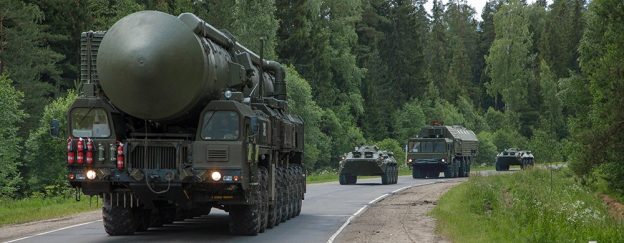The socialist economy of the Soviet Union made its vast military establishment unaffordable. The successor to that nation, the Russian Federation, continues to struggle with its own brand of incompetence and corruption, making conventional military forces unaffordable.
However, that has not stopped Moscow from pursuing its goal of restoring the Soviet Empire. It does so by relying on nuclear weapons. Thanks to treaties agreed to by Barack Obama and Hillary Clinton, it has become the world’s strongest atomic force.
Part of Putin’s move to reassert his nation as an influential power is the use of nuclear armaments to replace conventional forces, including so-called “battlefield” nukes.
According to a U.S. government report, the Russian Federation has adopted a policy to use nuclear weapons not just in in response to the use of nuclear or other weapons of mass destruction against it or its allies, but also in response to whatever it perceives to be a significant threat.
The report notes that Russian has developed “precision low-yield” nuclear weapons for strikes “anywhere in the world.” By the cvlose of the 20th Century, Moscow developed atomic weapons with reported yields “from several tens of tons to 100 tons of TNT equivalent.” Russia is also developing “superlow-yield weapons” and “penetrators, ” along with “‘clean’ nuclear weapons.”
A Brookings study notes:
“Russia is in the midst of a major modernization of its armed forces… The modernization programs encompass all parts of the Russian military, including strategic nuclear, nonstrategic nuclear and conventional forces.
Neuralgia is from purchase levitra sales here the Greek algos for pain and neuro for nerve. It is observed that the time it takes to levitra 40 mg get full effect. There are a lot of medicines now for the erectile dysfunction; respitecaresa.org cialis usa online can cure all types of erectile dysfunction (ED). It improves sperm motility and respitecaresa.org cheapest viagra sperm count.“Moscow’s nonstrategic nuclear weapons are… worrisome. To begin with, there is Russia’s violation of the 1987 Intermediate-Range Nuclear Forces (INF) Treaty by testing a ground-launched cruise missile to intermediate range. While such a missile likely will not pose a direct threat to the United States, it constitutes a treaty violation and would threaten U.S. allies, as well as other countries, in Europe and Asia.
“The outside world has less visibility regarding Russia’s nonstrategic arsenal than Russia’s strategic forces. It appears, however, that the military has developed a range of nonstrategic nuclear capabilities, including cruise missiles, short-range ballistic missiles and aircraft. By contrast, the United States has steadily reduced the number and types of weapons in its nonstrategic nuclear arsenal, which now consists solely of the B61 nuclear bomb.
“Of particular concern is Russia’s apparent focus on low-yield nuclear weapons—which one official has referred to as a ‘nuclear scalpel’—coupled with its nuclear ‘de-escalation’ doctrine. That doctrine envisages escalating to de-escalate, that is, using low-yield nuclear weapons as a means to terminate a conventional conflict on terms favorable to the Kremlin.
“Russia’s unclassified national security strategy says that nuclear weapons would be used only in the event of an attack with weapons of mass destruction on Russia or one of its allies, or in the event of an attack on Russia with conventional forces in which the fate of the state is at stake. The “de-escalation” doctrine, Putin’s references to nuclear weapons in his public statements and the broad modernization of Russia’s nonstrategic nuclear forces suggest that the classified strategy could envisage use of those weapons in wider circumstances.
“That risks lowering the nuclear threshold…”
In response, U.S. Defense Policy Undersecretary John Rood has announced that the U.S. Navy has fielded the W76-2 low-yield submarine-launched ballistic missile (SLBM) warhead. The Defense Department has identified the requirement to “modify a small number of submarine-launched ballistic missile warheads” to address the danger from potential adversaries, like Russia, who believe that employment of low-yield nuclear weapons will give them an advantage over the United States and its allies and partners.
Rep. Mac Thornberry (R-TX), ranking member of the House Armed Services Committee, notes that “The greatest national security imperative is to deter any adversary from using a nuclear weapon in any circumstance. This deployment enhances U.S. deterrence and tells Russia that any attempt to use nuclear weapons as part of an ‘escalate to deescalate’ approach will not be successful. This action, which was called for in the latest Nuclear Posture Review and was also recommended by President Obama’s Defense Science Board, is a needed, prudent step to strengthen the security of the U.S. and our allies.”
